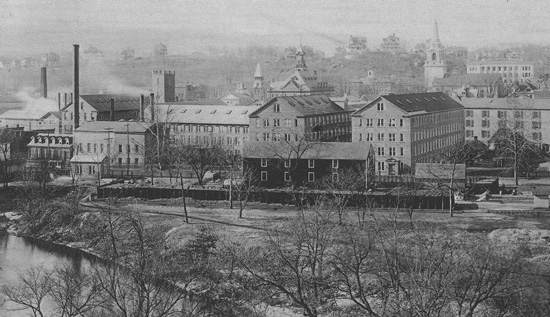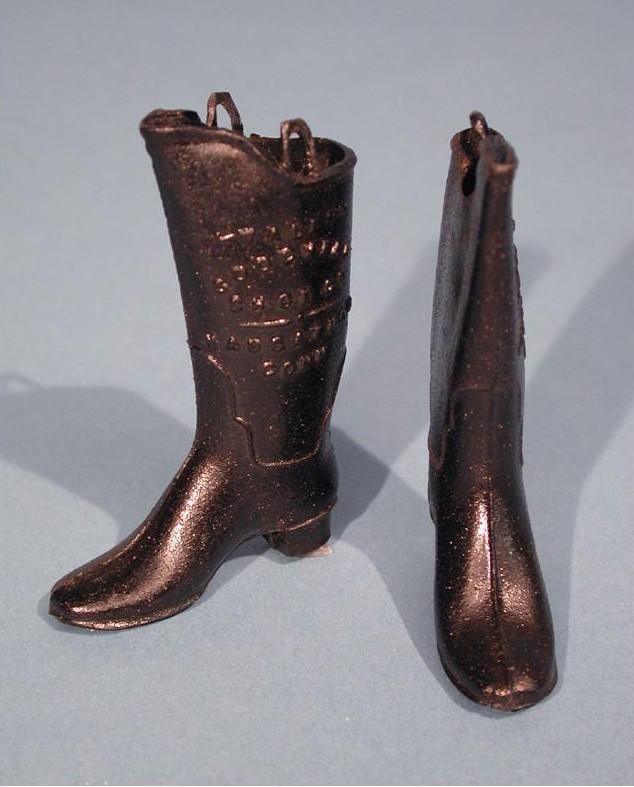By Ann Marie Somma
Charles Goodyear’s discovery of the vulcanization of rubber—a process that allows rubber to withstand heat and cold—revolutionized the rubber industry in the mid-1800s. Automotive tires, pencil erasers, life jackets, balls, gloves, and more are all in commercial use because of Goodyear’s relentless experimentation to unlock the molecular structure of rubber—and to solve what has been called the greatest industrial puzzle of the 19th century. Part scientist, part dreamer, part entrepreneur, Goodyear devoted his life, and sacrificed his family’s wealth and his own health, to the commercial improvement of rubber.
“Miracle Material” has Fatal Flaw
Born in 1800 in New Haven and raised in Naugatuck, Goodyear was 33 years old when he decided to venture into rubber products in the 1830s after his father’s New Haven hardware business went bankrupt. At that time, rubber appeared to be a “miracle material.” The gooey, milky sap, bled from trees in Brazil, was waterproof and easy to stretch. Called latex in its fluid form and rubber when it hardened, the substance could be formed to fit a variety of uses. Rubber barons and wealthy families staked their fortunes on its potential. But India rubber, as it was called at the time, had a flaw, and it was a fatal one: it melted in the summer and cracked in the winter. By the mid-19th century, the rubber industry was on the verge of collapse due to rubber products that sagged and melted into blobs in extreme temperatures.
Biographers have detailed Goodyear’s quest to find a way to stabilize rubber. It began with a visit in 1834 to the Roxbury India Rubber Company in New York. Inside the company store, Goodyear spotted rubber life vests the company made and sold, and he thought he could invent an improved valve for the vests. When he returned to the store to present his valve, the store manager said he should have invented a better use for rubber, not the valve. In Noble Obsession, author Charles Slack writes that the manager of the Roxbury India Rubber Company then led Goodyear to a warehouse where, “he pointed at rows of shelves containing heaps of misshapen blobs, their folds stuck fast together. The room was pungent and foul-smelling.”
A Near-Ruinous Quest to Stabilize Rubber
During the next five years, Goodyear became obsessed with rubber. He put his family in debt to finance experiments to make the material suitable for industrial use. He moved several times—to New York, Massachusetts, Philadelphia, and Connecticut. In short, he went anywhere he could find investors and places to conduct his experiments.
Goodyear mixed chemicals into raw rubber in pots and pans in makeshift laboratories that he set up in his wife’s kitchen and also in debtors’ prison, where he spent many nights for failing to pay his creditors. He inhaled the fumes of toxic concoctions, including nitric acid, lime, and turpentine, that he mixed together and kneaded into the rubber to make it stable.
There was no stopping Goodyear. When he ran out of money to pay for his experiments, he begged or sold his family’s furnishings, even his children’s textbooks. “He spared a set of china teacups, not out of sentiment but because they could double in the evenings as mixing bowls for rubber and turpentine,” biographer Slack wrote.
Goodyear thought he had found the answer when he discovered that nitric acid smoothed out rubber and made it less sticky. He won a contract from the United States Post Office in Boston to make rubber mailbags, but they, too, melted in hot weather.
He suffered a setback in 1837 when his family lost everything in that year’s national financial panic, but his luck changed in 1839 in a factory in Woburn, Massachusetts, where Goodyear now lived to be close to the rubber factories that had sprung up in the city. According to biographers, while working at the Eagle India Rubber Company, Goodyear accidentally combined rubber and sulfur upon a hot stove. Much to Goodyear’s surprise, the rubber didn’t melt. And, when he raised the heat, it actually hardened.
Naugatuck Emerges as Industry Hub
It would take Goodyear several more years to recreate the chemical formula and perfect the process of mixing sulfur and rubber at a high temperature; he patented the process in 1844, the year after establishing the Naugatuck India-Rubber Company in Naugatuck. Goodyear named his discovery vulcanization, after Vulcan, the Roman god of fire.

Goodyear Metallic Rubber Shoe Company, Naugatuck, ca. 1900
He licensed his patent to manufacturers and showcased it at exhibitions. The vulcanization process put Naugatuck, Connecticut, on the map as a leading site of rubber manufacturing during the 19th and 20th centuries. Numerous rubber companies operated in the town under the Goodyear license, including Uniroyal, which made the popular Keds sneakers. Even today, the town’s main thoroughfare is named Rubber Avenue.
Eventually, foreign competition would bring down the rubber industry in Naugatuck. Even Goodyear’s success was short-lived. He spent much of the fortune he earned from his patent fighting patent infringements in courts in the United States and abroad. Charles Goodyear died at 59 in 1860, $200,000 in debt. The Goodyear Tire and Rubber Co., founded in Akron, Ohio, in 1898, was named in his honor and the Goodyear Blimp bears his name.
Ann Marie Somma has worked as a print reporter for several newspapers in Connecticut including the Hartford Courant.









